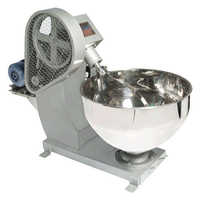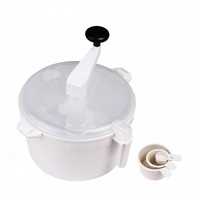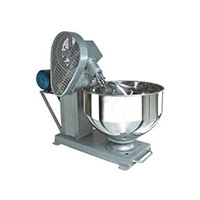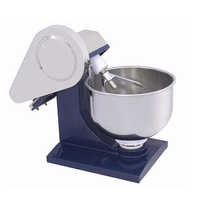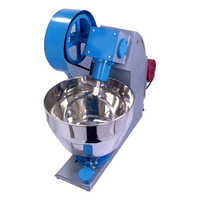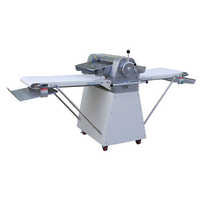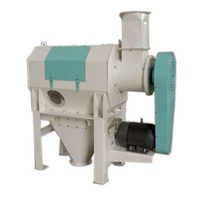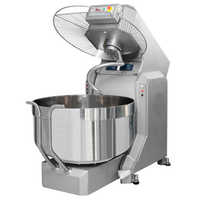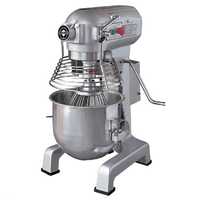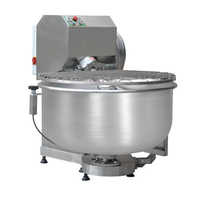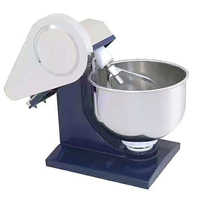Flour Kneading Machines
(729 products)
Explore More Categories
Made in India
Semi Automatic Flour Dough Kneading Machine
Price: 19000.00 INR (Approx.)/Unit
MOQ- 1 Unit/Units
Color - silver
Material - Stainless Steel
Automatic Grade - Semi Automatic
6 Years
The One Kitchen Equipment
Indian Inquiries Only
Made in India
Light Duty Flour Kneading Machine
Price: 52500 INR (Approx.)/Unit
MOQ - 1 Unit/Units
20 Years
Business Type: Manufacturer | Exporter
GAYATRI ENGINEERING WORKS
Table Top Dough Sheeter 2
4 Years
Business Type: Manufacturer | Supplier
KANTEEN INDIA EQUIPMENTS CO.
Indian Inquiries Only
Made in India
Fully Automatic Dough Sheeter Machine
Price Trend: 250000.00 - 1000000.00 INR (Approx.)/Piece
MOQ - 1 Piece/Pieces
Automatic Grade - Fully Automatic
Power Source - Electric
Dimension (L*W*H) - 2950 x 1010 x 1300 Millimeter (mm)
8 Years
Business Type: Manufacturer | Exporter
PRITUL MACHINES
Made in India
Stainless Steel Automatic Dough Making Machine
Price Trend: 18000.00 - 62000.00 INR (Approx.)/Piece
MOQ - 1 Piece/Pieces
Product Type - Automatic Dough Making Machine
Material - Stainless Steel
Automatic Grade - Fully Automatic
6 Years
Business Type: Manufacturer | Exporter
JACKSON MACHINE
Made in India
Atta Kneading Machine 7, Power: 0.5 to 5 Hp
20 Years
Response Rate: 86.29%
Business Type: Manufacturer | Distributor
JAS ENTERPRISE
Made in India
Semi Automatic Heavy Duty Dough Kneader
MOQ - 1 Piece/Pieces
Product Type - Heavy Duty Dough Kneader
Material - Stainless Steel
Automatic Grade - Semi Automatic
2 Years
Business Type: Manufacturer
PUNE KITCHEN
Small and Portable Atta Kneading Machine
Price Trend: 12000.00 - 30000.00 INR (Approx.)/Number
MOQ - 1 Number
Material - Stainless Steel
Power Source - Electric
15 Years
Business Type: Manufacturer | Exporter
ALFA MACHINE TOOLS
Made in India
Semi Automatic 50Kg Ss Dough Kneader Machine
Price: 58999 INR (Approx.)/Unit
MOQ - 1 Unit/Units
Motor - Electric
Product Type - Dough Kneader
Material - Stainless Steel
1 Years
Business Type: Manufacturer | Distributor
JK ENTERPRISE
Made in India
Dough Kneader Machines
3 Years
Business Type: Manufacturer | Distributor
JANSHAKTI INDUSTRIES
Made in India
Dough Rounder
3 Years
Business Type: Manufacturer | Trading Company
ARNAV HOSPITALITY
Indian Inquiries Only
White And Black Dough Mixer
Price Trend: 10000000.00 - 100000000.00 INR (Approx.)/Piece
MOQ - 1 Piece/Pieces
Product Type - Dough Mixer, Other
Material - Stainless Steel
Voltage - 220 to 340 Volt (v)
10 Years
Business Type: Manufacturer | Supplier
Arun Laser Ovens Pvt. Ltd
Made in India
Fully Automatic Flour Mill Plant
Price: 285000 INR (Approx.)/Unit
MOQ - 1 Unit/Units
Product Type - Flour Mill Plant
Material - Stainless Steel
Automatic Grade - Fully Automatic
2 Years
Business Type: Manufacturer | Distributor
Bhagirath Engineering Works
Made in India
Semi Automatic Besan Mixing Machine
Price: 32000.00 INR (Approx.)/Unit
MOQ - 1 Unit/Units
Color - Silver
Motor - 1.5 Hp
Product Type - Besan Mixing Machine
6 Years
Business Type: Manufacturer | Distributor
THE ONE KITCHEN EQUIPMENT
Indian Inquiries Only
Made in India
Fully Automatic Industrial Dough Kneader Machine
Price: 25000 INR (Approx.)/Unit
MOQ - 1 Unit/Units
Color - Silver
Product Type - Industrial Dough Kneader Machine
Material - Stainless Steel
4 Years
Business Type: Manufacturer | Supplier
VINPAT MACHINERY (OPC) PRIVATE LIMITED
Made in India
Semi Automatic Flour Mixer Machine
Price: 280000 INR (Approx.)/Unit
MOQ - 1 Unit/Units
Color - Blue
Product Type - Flour Mixer Machine
Material - Other
20 Years
Business Type: Manufacturer | Exporter
SREE VALSA ENGINEERING COMPANY
Made in India
Commercial Grade Flour Mixing Machine
Price: 24152.54 INR (Approx.)/Number
MOQ - 1 Number
Color - Silver
Product Type - Flour Mixing Machine
Material - Stainless Steel
14 Years
Business Type: Manufacturer | Exporter
Devika Industries Inc
Dough Kneader
11 Years
Business Type: Manufacturer | Distributor
M. M. INDUSTRIES
10 KG Flour Mixing Machine
Price Trend: 8000-125000 INR (Approx.)/Piece
MOQ - 1 Piece/Pieces
4 Years
Business Type: Manufacturer | Supplier
PRAGATI ENGGINEERS
Made in India
Kitchen Rotary Kneading Machine
6 Years
Business Type: Manufacturer | Distributor
DHIMAN INDUSTRIES (REGD.)
Made in India
Semi-Automatic 4 Rold Semi Automatic Dank- Kandap Machine
Price: 81225 INR (Approx.)/Piece
MOQ - 1 Piece/Pieces
Motor - 2 HP
Product Type - Kandap Machine
Material - Mild Steel
2 Years
Business Type: Manufacturer | Distributor
AMAR INDUSTRIES
High Performance Dough Mixer
20 Years
Business Type: Manufacturer | Supplier
S. F. ENGINEERING WORKS
Made in India
Semi Automatic Leenova Flour (Kneading) Mixing Machine
Price: 23600 INR (Approx.)/Piece
MOQ - 1 Piece/Pieces
Motor - Single Phase
Product Type - Food Processing
Material - Stainless Steel
10 Years
Response Rate: 86.67%
Business Type: Manufacturer | Exporter
LEENOVA KITCHEN EQUIPMENTS PRIVATE LIMITED
Dough Kneader Capacity: 25 Kg In 20 Minutes Liter/Day
Price: 1.00 INR (Approx.)/Piece
MOQ - 1 Piece/Pieces
Product Type - Hotel Kitchen Equipment
Material - Stainless Steel
Power - Electric Watt (w)
10 Years
Business Type: Manufacturer | Supplier
J. B. EQUIPMENTS
Made in India
Semi Automatic Dough Mixer
Price: 21000 INR (Approx.)/Set
MOQ - 1 Set/Sets
Color - Silver
Product Type - Dough Mixer
Material - Stainless Steel
6 Years
Business Type: Manufacturer | Distributor
GLOBAL MARKETING EMPIRE
Indian Inquiries Only
Made in India
Semi Automatic Stainless Steel Maida Mixing Machine
Price: 84999 INR (Approx.)/Unit
MOQ - 1 Unit/Units
Gross Weight - 150 Kilograms
Color - Customized
Motor - Electric
7 Years
Response Rate: 90.91%
Business Type: Manufacturer | Distributor
CHOTIWALA FOODS AND MACHINES
Fully Automatic Electric Dough Mixer
MOQ - 1 Unit/Units
Product Type - Dough Mixer
Automatic Grade - Fully Automatic
Power Source - Electric
Business Type: Manufacturer | Distributor
Shanghai Jinghua Food Machinery Co., Ltd.
Flour Mixer 6
4 Years
Business Type: Manufacturer | Exporter
SARVESHWAR MACHINE TOOLS
Semi Automatic Dough Kneader
Price: 45000 INR (Approx.)/Piece
MOQ - 1 Piece/Pieces
Product Type - Dough Kneader
Automatic Grade - Semi Automatic
Power Source - Electric
7 Years
Response Rate: 70.00%
Business Type: Manufacturer | Distributor
SHALOM MACHINE WORKS
Flour Kneading Machines Manufacturers | Suppliers in India
| Company Name | Location | Member Since |
|---|---|---|
| Gayatri Engineering Works | Anand, India | 20 Years |
| Jas Enterprise | Ahmedabad, India | 20 Years |
| Sree Valsa Engineering Company | Coimbatore, India | 20 Years |
| S. F. Engineering Works | Mira Bhayandar, India | 20 Years |
| Alfa Machine Tools | Junagadh, India | 15 Years |
| Devika Industries Inc | Rajkot, India | 14 Years |
| M. M. Industries | Rajkot, India | 11 Years |
| Arun Laser Ovens Pvt. Ltd | Coimbatore, India | 10 Years |
| Leenova Kitchen Equipments Private Limited | Rajkot, India | 10 Years |
| J. B. Equipments | New Delhi, India | 10 Years |
What is a Kneading Machine?
Uses & Benefits of Kneading Machine
- The better blending of secondary ingredients
- greater precision in recipe analysis and less room for error
- rates of 100 to 10,000 kg/hr of dough production
- less occupying of physical space; more compact
- food safety is increased because the dough is never left out in the open.
- work more efficiently than traditional batch mixing while requiring less time and resources to operate
- Temperatures can be precisely and uniformly regulated because of the abundant heat transfer areas.
- Processing in real-time or in batches
- Accumulation of Process Intensity
- Products with high viscosity and a sticky consistency can be processed.
- The velocity of the agitator does not affect the amount of time a substance spends in
- Extensive and malleable variation in typical stays
- Large ratio of turndown
Types of Kneading Machine
Things to Consider Before Buying a Kneading Machine
FAQs: Kneading Machines
- Hamilton Beach Electric 7 Speed Stand Mixer: Affordable Dough Maker
- Cuisinart SM-50BC Stand Mixer
- Breville BHM800 Hand Mixer
- Oster CKSTBRTW20 Bread Machine
